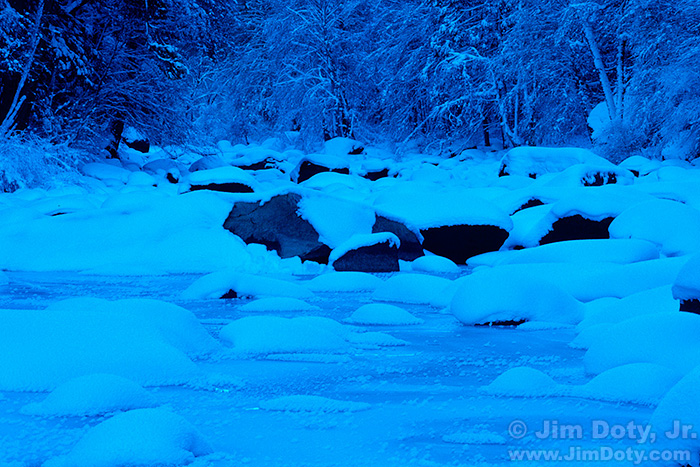Just like metering daytime winter scenes, the key to metering evening winter scenes is knowing what to meter and deciding how much exposure compensation to use.
Everything in the Metering Snow Winter Scenes article still applies, and it would be helpful to read that article if you haven’t already. In order to meter known tonal values, meter only the snow so the camera meter isn’t fooled by darker tones in the scenes. Then apply some exposure compensation. The key is to add less light than metering snow in the daytime. For daytime scenes you want the snow to be light and bright so you will typically add 1 1/2 to 2 stops of “plus” exposure compensation (+1 1/2 to +2) to the meter reading your camera came up with. But that is too much for an evening scene.
Much of the charm of an evening winter scene is the cool (bluish) color temperature of the light. The blue tint on the snow makes the scene. Adding 1 1/2 to 2 stops of light will wash out much of that blue tone and give you a scene that looks more like daytime than evening.
So how much “plus” exposure compensation should you add? That is a matter of personal taste. I would suggest +1/2 to +1 at the most. For really rich, blue snow, just meter the snow and don’t add any exposure compensation at all. In the photo above I added about +1/2 stop of exposure compensation to the snow hummocks.
It is very important that you set the white balance on your camera to daylight (indicated on many camera by a symbol for the sun). A daylight white balance will render the cool, blue light as it really is – blue. If you set the camera to automatic white balance, it will try to make the light “neutral” in tone by shifting the snow from blue to white.
This photo is the Merced River in Yosemite National Park. Yosemite is a magical place right after a heavy snow. If you have a chance to be in Yosemite after a winter snowfall, by all means go. You will end up with some of your favorite photographs.
Links
Why Is Exposure So Important? The first in a series series of articles covering the basics of exposure with links to the rest of the series.
Speaking Your Camera’s Language: Aperture, Shutter Speed, and ISO (thinking in stops).
Using Reflected Light Meters, Part One (with a section on exposure compensation).
A comprehensive guide to exposure (everything from the basics to advanced exposure techniques) is in my five star rated book, Digital Photography Exposure for Dummies. You can learn more here and order it at Amazon.com.
Yosemite National Park – the official NPS site.

